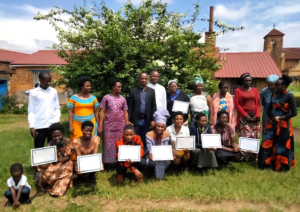 The Missionary Sisters of Our Lady of Africa, participated in the founding and formation of 22 African religious congregations. The story of a great adventure !
The Missionary Sisters of Our Lady of Africa, participated in the founding and formation of 22 African religious congregations. The story of a great adventure !
Historical background:
Feminine religious life is not new in Africa. We think for example, of the nuns of the Coptic Church. In the nineteenth century, young women entered the recently established international missionary Institutes (West Africa, Sudan). The novelty in the early twentieth century was the birth of truly indigenous active congregations. That happened as “missions” were established in the new evangelized territories.
 Religious life in Africa:
Religious life in Africa:
The Missionary Sisters of Our Lady of Africa, under the leadership of their founder, Cardinal Charles Lavigerie, collaborated in the formation of 22 new congregations.
The first was born in Sumbawanga (now in Tanzania) in 1903. Other foundations followed throughout the twentieth century in: Uganda, Rwanda, Congo, Zambia, Burundi, Malawi, Burkina Faso, Mali, Ghana, and Kenya. Most often, the sisters answered the call of apostolic vicars or bishops asking them to take on the formation of the future indigenous religious. Often it happened that the Sisters found in very young girls a desire to consecrate themselves, born in them long before any contact with the sisters. Others had tried by themselves to form a community of life.
From the beginning, there were many obstacles: families were opposed to what was for them an incomprehensible form of life; the difficulty to live together when we are from different ethnic groups; low academic achievement, material concerns, difficulties in relationships with certain priests or bishops … But the sisters remained firm.
The Missionary Sisters of Our Lady of Africa accompanied these Congregations right up to their autonomy. Initially, the superiors general, novice mistresses and treasurers were European or Canadian. Then gradually the Congregations became autonomous. In 1976, there were a total of 3,000 members. In 2008, they were close to 5000. In 1970, in French-speaking West Africa, The Union of African Superiors General was formed and, in 1974, the English counterpart, as part of AMECEA (African Bishops’ Conference of Eastern Africa). Various superiors have participated in the UISG (International Union of Superiors General) from its beginning in Rome in 1966.
At the same time, many of these new Congregations have gone beyond the borders of their birth country: from Rwanda to Chad, from Mali to Algeria. Others even open communities in Europe. The missionary spirit instilled from the beginning is still alive.
We can add in conclusion that from 1960, some African girls chose to enter the Congregation of the Missionary Sisters of Our Lady of Africa, really finding their place as missionaries, ready to be sent to any part of Africa. They all insist: “Jesus Christ died for all of us and should we not proclaim it?”
Sister Suzanne







